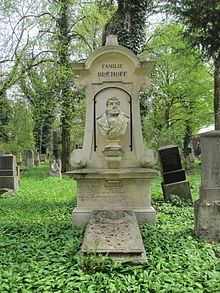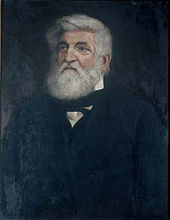Theodor von Bischoff
Theodor Ludwig Wilhelm von Bischoff (born October 28, 1807 in Hanover , † December 5, 1882 in Munich ) was a German anatomist , embryologist and physiologist .
Live and act
He was the son of the physician and pharmacologist Christoph Heinrich Ernst Bischoff , studied medicine in Bonn from 1826 and then did his doctorate. After his assistantship he completed his habilitation in 1833 and became an associate professor of anatomy in Bonn and from 1835 in Heidelberg. In 1839 he married Kunigunde Tiedemann (1809–1889). In 1843 Bischoff was appointed full professor of anatomy and in 1844 also of physiology at the University of Giessen , where he took over the development and, until 1855, the supervision of the anatomical and physiological institute. There he was friends with Justus von Liebig . He later followed the call for a professorship for anatomy and physiology in Munich (1856–1878). He created important foundations in the research areas of physiology and embryology . He recognized the importance of the menstrual cycle (the provision of an egg that is ready for fertilization) and made important contributions to the development of eggs in dogs, rabbits, etc. He thought nothing of Darwinism and sharply rejected Ernst Haeckel's embryological interpretations.
The Senckenberg Natural Research Society awarded him the Soemmering Prize for his research . In 1843 he was also elected a member of the Leopoldina Scholars' Academy , in 1849 in the American Academy of Arts and Sciences , in 1846 as a corresponding member in the Russian Academy of Sciences , in 1853 as a corresponding member in the Göttingen Academy of Sciences and in 1854 also as a corresponding member accepted into the Prussian Academy of Sciences . From 1868 he was a foreign member of the Royal Society .
The especially female posterity, however, made Bischoff remembered because of his vehement opposition to medical studies for women. Bischoff concluded from results of the comparative brain and skull anatomy the intellectual inadequacy of women for studying and exercising an academic profession. In particular, he denied women access to medicine, which he justified in 1872 as follows: “The preoccupation with the study and practice of medicine contradicts and violates the best and noblest aspects of feminine nature, modesty, modesty, compassion and mercy which distinguishes it from the male. ” Bischoff was also of the opinion that women are physically unsuitable for exercising the medical profession, whereby he referred to measurements on the skeleton, circulation, muscles, etc. With today and also in his time dubious scientific methods and just as much ideological effort, Bischoff contributed to preserving the old gender-specific and hierarchical role models. He reacted (also supported by his successor Nikolaus Rüdinger ) to efforts to emancipate women , at the same time his writings also stimulated counter-responses to, among others, Hedwig Dohm Die Antifeministen . See also Carl Brühl (Vienna).
Theodor von Bischoff was one of many respected scientists of his time who spoke out against women at universities, but there were also numerous professors who, in Arthur Kirchhoff's study Die Akademische Frau (1897), expressed themselves in favor of admitting women to university. After 1900 women were gradually admitted to study in the states of the German Empire (in Bavaria 1903, in Württemberg 1904, in Saxony 1906, in Thuringia 1907, in Hesse and Prussia 1908 and in Mecklenburg 1909)
tomb

Bischoff's grave is located in the Old Southern Cemetery in Munich (Gräberfeld 42, row 13, place 14, location ). the bust on the grave comes from the sculptor Christoph Roth (* July 22, 1840, Nuremberg † March 22, 1907, Munich) a student of Anselm Sickinger and Joseph Knabl . Theodor von Bishop's wife Kunigunde von Bischoff (née Tiedemann, born March 3, 1809, Nuremberg † March 23, 1889) is also buried in the grave. Kunigunde had originally acquired the grave site in 1861 for her father, the anatomist and physiologist Friedrich Tiedemann (* 23 August 1781 in Kassel, † 22 January 1861 in Munich), before the grave site was converted into the Bischoff family grave and enlarged when her husband died in 1883 has been.
swell
- Edith Glaser: “Are women capable of studying?” Prejudices against women's studies. In: Elke Kleinau, Claudia Opitz (Ed.): History of girls and women education. Volume 2.
- Heinz-Jürgen Voß: Making Sex Revisited: Deconstructing gender from a biological-medical perspective. Transcript Verlag, Bielefeld 2010.
literature
- Robert Ritter von Töply: Bischoff, Theodor Ludwig Wilhelm . In: Allgemeine Deutsche Biographie (ADB). Volume 46, Duncker & Humblot, Leipzig 1902, p. 570.
- Friedrich Mattick: Bischoff, Theodor von. In: New German Biography (NDB). Volume 2, Duncker & Humblot, Berlin 1955, ISBN 3-428-00183-4 , pp. 264-266 ( digitized version ).
- Michael Kutzer: Bischoff, Theodor Ludwig Wilhelm. In: Werner E. Gerabek , Bernhard D. Haage, Gundolf Keil , Wolfgang Wegner (eds.): Enzyklopädie Medizingeschichte. De Gruyter, Berlin / New York 2005, ISBN 3-11-015714-4 , p. 184.
Individual evidence
- ↑ Kunigunde was married to Vincenz Fohmann in his first marriage and to Theodor von Bischoff in his second marriage.
- ^ Foreign members of the Russian Academy of Sciences since 1724. Theodor Ludwig Wilhelm Bischoff. Russian Academy of Sciences, accessed August 1, 2015 .
- ↑ Holger Krahnke: The members of the Academy of Sciences in Göttingen 1751-2001 (= Treatises of the Academy of Sciences in Göttingen, Philological-Historical Class. Volume 3, Vol. 246 = Treatises of the Academy of Sciences in Göttingen, Mathematical-Physical Class. Episode 3, vol. 50). Vandenhoeck & Ruprecht, Göttingen 2001, ISBN 3-525-82516-1 , p. 40.
- ^ Members of the previous academies. Theodor Ludwig Wilhelm von Bischoff. Berlin-Brandenburg Academy of Sciences , accessed on March 23, 2015 .
- ^ Entry on Bischoff, Theodor Ludwig Wilhelm (1807–1882) in the archive of the Royal Society , London
- ↑ Claudia Denk, John Ziesemer: "Grabstätte 186" in Art and Memoria, Der Alte Südliche Friedhof in Munich (2014), p. 497 ff and p. 506
Web links
| personal data | |
|---|---|
| SURNAME | Bischoff, Theodor von |
| ALTERNATIVE NAMES | Bischoff, Theodor Ludwig Wilhelm von |
| BRIEF DESCRIPTION | German anatomist and physiologist |
| DATE OF BIRTH | October 28, 1807 |
| PLACE OF BIRTH | Hanover |
| DATE OF DEATH | December 5, 1882 |
| Place of death | Munich |

